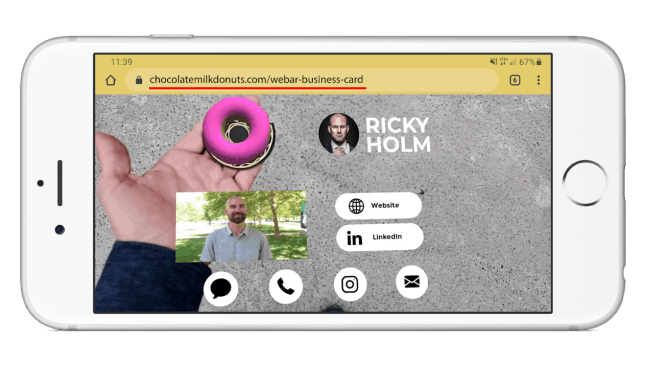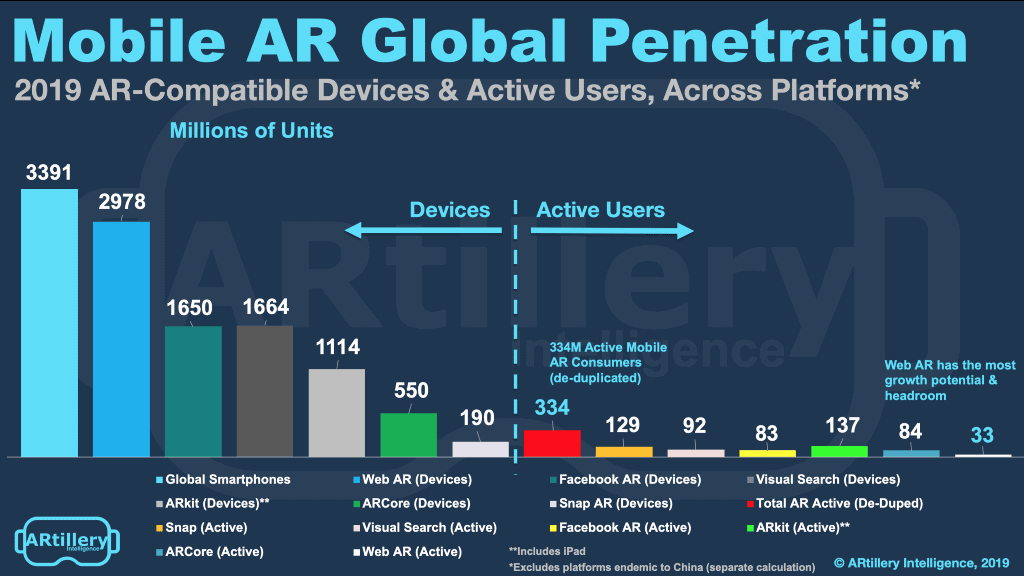WebAR or web-based augmented reality is a digital technology that allows you to easily share augmented reality experiences right over the Internet, no app required! Simply send your users to a specific URL and boom they’re immediately interacting with your latest digital experience. Add interactivity to your next print ad, include a fully interactive product demo right on the back of your business card, or bring a product label to life!
Learn about our WebAR development services here:
Mobile-based augmented reality, the type of AR that runs on your mobile phone or tablet, has been exploding in popularity over the last couple of years. However, there’s always been a bit of a hiccup. Users would first need to go download an app in order to enjoy your experience. With WebAR, that is no longer the case. Augmented reality can now live right on the web!
Wearable augmented reality technology, sometimes referred to as mixed reality (MR), is another kind of AR that grabs a lot of headlines. However, this tech is likely still 5-10 years away from being consumer ready. MR is enjoyed through some kind of wearable device like a set of AR goggles. Common products you may have heard of in this space include MagicLeap One and the Microsoft Hololens. Apple has also been teasing a pair or AR glasses for some time, but we’ll have to just wait and see what comes of that.
Why consider WebAR?
Studies show that by adding interactivity to content, messaging can be up to 80% more effective. That’s right, by adding interactivity to your messaging, that information can be up to 80% more sticky in the user’s mind. In addition, you can now share AR content right from your own website. No need to send users to a 3rd-party site like Facebook, Snapchat, or TikTok. You can launch WebAR experiences from any URL of your choosing.
Similar to static websites, there is also a whole host of different tracking and analytics available when using WebAR. Not only can you track traditional metrics like engagements, time on page, etc. You can also get more granular insights like how long did a user interact with a particular product if a user ‘tried something on’ while using your experience or even capture information on a consumers size.

Don’t be a data doop! Data protection is incredibly important, and with advancements in technologies like eye-tracking, facial recognition, and image targeting, the power to collect personal information is only growing. (These technologies are sometimes required be build virtual and augmented reality experiences.) It is more important now than ever that we as digital content creators treat this power with respect.
How to get started with WebAR
Leveraging the power of WebAR couldn’t be simpler. All you need to do is get your audience to a specific URL and that’s it. One of the easiest ways to do this is through the power of QR codes. By adding a QR code to your next print campaign, magazine ad, press release, or latest round of business cards, you can now add interactivity to any of these marketing materials.
Users simply open the camera app on their phone, point their lens at the QR and that’s it! They’re immediately enjoying your new WebAR experience. This technology allows to you easily ‘embed’ interactive content anywhere. If you’d prefer to avoid using QR codes, you can also simply list or share your AR-enabled URL. To reiterate, the important part here is to get your users to a specific webpage. Your new WebAR experience will launch automatically.
WebAR experiences can also be engineered to include fallbacks for those audience members browsing on older devices or on slow bandwidth connections. This is a great practice to follow to help ensure your entire audience has a great experience.
The development process for building a WebAR experience is similar to that of other digital experiences. Keep an eye for another blog in the near future detailing this procedure. You can learn more about WebAR development in the meantime here.
Where is the tech today?
Companies like Google, Apple and Mozilla have been working for years behind the scenes to help make WebAR a reality. Serious research and development efforts on WebAR began in the 2000s and started to really ramp up in the last 3-5 years. These efforts have paid off, and this technology is now ready for prime time!
WebAR is supported by all major mobile phone manufacturers (Samsung, Apple, HTC, Xiaomi, Huawei, etc) and across all major web browsers (Safari, Chrome, Firefox, etc). As consumers and creators, this means we now have access to over three billion sets of eyeballs when we publish a WebAR experience. So as long as your consumer is using anything newer than an iPhone 6, you’re probably good to go. Interested to see how this works in the real world, check out the WebAR business cards by CM&D here.

In addition to mobile phone technology, you may also hear people throwing around the term ‘development platform’ when discussing WebAR. Like other development solutions, these are just software packages that make our (technology developers) lives easier. These platforms give us access to the base technologies needed to build amazing WebAR experiences providing tools like surface tracking, image recognition and more. The two most common WebAR development platforms on the market today are 8thWall and Zappar. Both have their own benefits and drawbacks. A good WebAR development partner (like us!) can help you decide which is best for your particular project.
What do I need to be aware of when considering WebAR?
When comparing WebAR to traditional mobile AR technology, there are a few limitations you’ll want to keep in mind around graphic fidelity and frame rate. When using WebAR, you are restricted by the speed of your user’s network connection. Detailed 3D models, complex animations, and large scenes containing high-levels of detail can lead to a subpar user experience. You’ll want to make sure you follow all the best practices around compression and low-poly art creating when developing a WebAR experience. This will help keep your experience running smoothly across all devices and network connections. As mentioned above, a good developer should also program in a fallback solution for those users tapping in on slow connections or out-of-date phones.
When considering WebAR as part of your next sales, marketing or advertising campaign, do also keep in mind that this is just one tool in your toolbox as a digital content creator. Building a quality WebAR experience is more about just leveraging the tech to make something cool. Think about how you can use these experiences to tie together a larger campaign, tell a more compelling story or make something more shareable. Have a WebAR idea you’ve been kicking around but need a little help getting it over the finish line? Give us a shout, we’re here to help. Ideas are always free!
A quick note on 5G technology
5G is promising mobile internet speeds 5-10x faster than the fastest 4G connection. What does this mean for WebAR? Imagine watching an NFL football game playout in 3D right on your dining room table. Or perhaps having a phone call with your interior designer while being able to see new paint colors and furniture options appear in your living room in realtime. 5G technology is going to be a game-changer for WebAR and other interactive technologies like WebVR and 360 video live streaming. The experiences we’re seeing today (as powerful as they are!) are just the beginning.

Get started with WebAR today
With WebAR technology, you now have the power to add interactivity to any product label, promotional poster or print ad. Brands like Adidas, Coors beer and the Spider-Man franchise are already leveraging the power of WebAR and seeing real results. How could you use WebAR to bolster your next campaign!?
At CM&D we always offer free advice, ideas and project consultation. Have an idea you want to discuss or need help with a WebAR question? Give us a shout today, we’re here to help. Donuts included.
This article has also been published on BuiltIn as part of their Expert Contributor Network.


